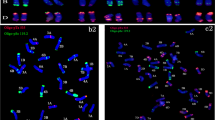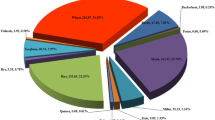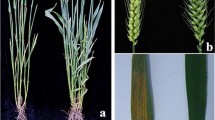Summary
Eight grain pearl millet (2n=14) accessions were crossed as male to hexaploid spring wheat cv. ‘Fukuho’ (2n=6x=42). An average of 80% wheat pistils showed pearl millet pollen tube entry in the ovules, compared to 56% in wheat x maize cv. ‘Seneca 60’ cross. Of the 15 embryos, obtained through in vitro immature seed culture from wheat x pearl millet crosses, 3 plantlets were produced and grown to maturity. These three were of the somatic chromosome constitution 2n=42, 21 and 22, respectively. Haploid wheat plant (2n=21) apparently originated from pearl millet chromosome elimination during embryogenesis. The 22 chromosome plant had retained a single pearl millet chromosome at tillering stage, but this chromosome was eliminated from pollen mother cells prior to and also during gamete formation. The significance and potential uses of this wide cross is discussed.
Similar content being viewed by others
References
Barclay, I.R., 1975. High frequencies of haploid production in wheat (Triticum aestivum) by chromosome elimination. Nature 256: 313–316.
Comeau, A., G., Fedak, C.A., St-Pierre & C., Theriault, 1985. Intergeneric hybrids between Triticum aestivum and species of Agropyron and Elymus. Cereal Res. Commun. 13: 149–153.
Comeau, A., A. Plourde, C.A. St-Pierre & P. Nadeau, 1988. Production of doubled haploid wheat lines by wheat x maize hybridization. Genome (Suppl. 1): 482.
Comeau, A., P. Nadeau, A. Plourde, C.A. St-Pierre, R. Simard, O. Maës & S. Kelly, 1990. Media for the culture of proembryos and ovules of wheat and other Gramineae. Plant Sci. Lett. (submitted).
Falk, D.E. & K.J., Kasha, 1981. Comparison of the crossability of rye (Secale cereale) and Hordeum bulbosum onto wheat (Triticum aestivum). Can. J. Genet. Cytol. 23: 81–88.
Fedak, G., 1977. Haploids from barley x rye crosses. Can. J. Genet. Cytol. 19: 15–19.
Fedak, G., 1985. Alien species as sources of physiological traits for wheat improvement. Euphytica 34: 673–680.
Hadley, H.H. & S.J., Openshaw, 1980. Interspecific and intergeneric hybridization. In: W.R., Fehr & H.H., Hadley (Eds). Hybridization of crop plants. pp. 133–159. American Society of Agronomy and Crop Science Society of America, Madison, Wisconsin, USA.
Human Gene Mapping, 7, 1984. Cytogenet. Cell Genet. 37: Parts 1–4.
Inagaki, M., 1986. Crossability of Japanese wheat cultivars with Hordeum bulbosum L. Japan. J. Breed. 36: 363–370.
Inagaki, M. & J.W., Snape, 1982. Frequencies of haploid production in Japanese wheat varieties crossed with tetraploid Hordeum bulbosum L. Japan. J. Breed. 32: 341–347.
Kasha, K.J. & K.N., Kao, 1970. High frequency of haploid production in barley (Hordeum vulgare L.). Nature 225: 874–876.
Laurie, D.A. & M.D., Bennett, 1986. Wheat x maize hybridization. Can. J. Genet. Cytol. 28: 313–316.
Laurie, D.A. & M.D., Bennett, 1987. The effect of crossability loci Kr1 and Kr2 on fertilization frequency in hexaploid wheat x maize crosses. Theor. Appl. Genet. 73: 403–409.
Laurie, D.A. & M.D., Bennett, 1988a. Cytological evidence for fertilization in hexaploid wheat x sorghum crosses. Plant Breeding 100: 73–82.
Laurie, D.A. & M.D., Bennett, 1988b. The production of haploid wheat plants from wheat x maize crosses. Theor. Appl. Genet. 76: 393–397.
Laurie, D.A. & M.D., Bennett, 1988c. Wheat x maize and barley x maize hybridization. Maize Genet. Coop. Newsl. 62: 36–37.
Martin, A.R.H. & J.C., Herscovitch, 1989. Fertilizing pollen tubes parasitise ovary wall in Grevillea. Ann. Bot. 64: 163–165.
Mujeeb-Kazi, A. & G., Kimber, 1985. The production, cytology and practicality of wide hybrids in the Triticeae. Cereal Res. Commun. 13: 111–124.
Nitsch, C., K., Mornan & M., Godard, 1986. Intergeneric crosses between Zea and Pennisetum reciprocally by in vitro methods. In: D.L., Mulcahy, G.B., Mulcahy & E., Ottaviano (Eds). Biotechnology and Ecology of Pollen. pp. 53–58. Springer-Verlag, New York, Berlin, Heidelberg, Tokyo.
Pickering, R.A., 1984. The influence of genotype and environment on chromosome elimination in crosses between Hordeum vulgare L. and Hordeum bulbosum L. Plant Sci. Lett. 34: 153–164.
Simpson, E., J.W., Snape & R.A., Finch, 1980. Variation between Hordeum bulbosum genotypes in their ability to produce haploids of barley, Hordeum vulgare. Z. Pflanzenzücht. 85: 205–211.
Sitch, L.A. & J.W., Snape, 1987. Factors affecting haploid production in wheat using the Hordeum bulbosum system. 1. Genotypic and environmental effects on pollen germination, pollen tube growth and the frequency of fertilization. Euphytica 36: 483–496.
Snape, J.W., V., Chapman, J., Moss, C.E., Blanchard & T.E., Miller, 1979. The crossabilities of wheat varieties with Hordeum bulbosum. Heredity 42: 29–298.
Stalker, H.T., 1980. Utilization of wild species for crop improvement. Adv. Agron. 33: 111–147.
Suenaga, K. & K., Nakajima, 1989. Efficient production of haploid wheat (Triticum aestivum) through crosses between wheat and maize (Zea mays). Plant Cell Rep. 8: 263–266.
Thomas, J.B., P.J., Kaltsikes & R.G., Anderson, 1981. Relationship between wheat-rye crossability and seed set of common wheat after pollination with other species in the Hordeae. Euphytica 30: 121–127.
Virmani, S.S. & B.S., Gill, 1972. Somatic chromosomes of Pennisetum typhoides (Burm.). S. and H. Cytologia 37: 257–260.
Wet, J.M.J.de, S.C., Gupta, J.R., Harlan & C.O., Grassl, 1976. Cytogenetics of introgression from Saccharum into Sorghum. Crop Sci. 16: 568–572.
Wu, S. & J., Wang, 1963. Cytological studies on the intergenomic F1 hybrid between Oryza sativa x Pennisetum sp. Acta Bot. Sin. 11: 293–307.
Zu, D., C., Shanbao, D., Xiaolan, J., Fu, X., Song, Y., Luo, L., Li & B., Xie, 1985. Genetic variations in the hybrids of rice (Oryza sativa) and sorghum (Sorghum vulgare). Theor. Appl. Genet. 70: 542–547.
Author information
Authors and Affiliations
Rights and permissions
About this article
Cite this article
Ahmad, F., Comeau, A. Wheat x pearl millet hybridization: consequence and potential. Euphytica 50, 181–190 (1990). https://doi.org/10.1007/BF00023643
Received:
Accepted:
Issue Date:
DOI: https://doi.org/10.1007/BF00023643




